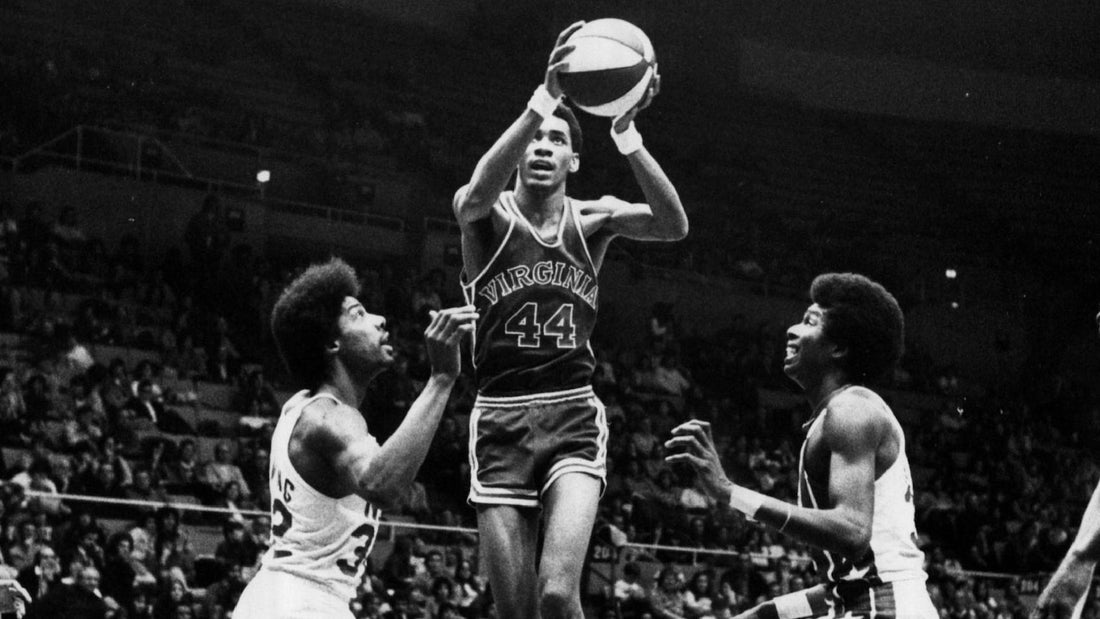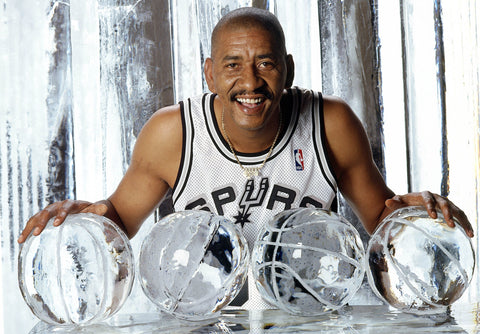The Legend of George “Iceman” Gervin
Iceman had the Finger Roll, the Nike Blazers, the appearances at historic St. Cecilia, the effortless scoring, the gold chains, the Cadillacs, Gervin was a superstar in his day. One of the coldest scorers to ever touch a basketball was appropriately named “Ice”.
Smooth. Graceful. Creative. Unstoppable. George "Iceman" Gervin was one of basketball's most electrifying players and best scorers. During his career in the NBA he had four scoring titles, only Wilt and MJ had more. “He’s the one player I would pay to see,” Jerry West told the Los Angeles Times in 1982 after Gervin won his fourth scoring title. Longtime NBA coach Dick Motta told the Sacramento Bee that same year, “You don’t stop George Gervin. You just hope that his arm gets tired after 40 shots. I believe the guy can score when he wants to. I wonder if he gets bored out there.”
The Detroit native finished with an NBA career average of 26.2 points per game, recording a streak double figures scoring in 407 consecutive games. In 1996, Gervin was named as one of the 50 Greatest Players in NBA History, and in 2021 Ice was named as one of the 75 greatest players. He played in 12 straight All-Star Games, including nine in the NBA and he averaged at least 21 points in each of those dozen years.
George Gervin Finger Rolls
High School Career at MLK in Detroit
Born and bred in Detroit, Gervin attended Martin Luther King High School where he struggled on the court. As a 5-foot-8 sophomore, Gervin tried out for the basketball team at Martin Luther King High School.Although he could move well, he needed some work on his shot. “Cut him,” the head coach told his assistant, Willie Meriweather, who also oversaw the junior varsity team. But Meriweather liked Gervin, so he persuaded the varsity coach to allow him to carry an extra player on the junior varsity squad. Meriweather and Gervin grew close. “He was my teacher,” Gervin told the Sacramento Bee. “He was basically like a father to me.”
The teen quickly realized the need to improve his shot when he unsuccessfully tried out for the varsity basketball team his junior season. He was determined to improve his game, so he eventually struck up a friendship with the school janitor, who allowed Gervin to stay in the gym for extra time, as long as he made sure to sweep up before leaving.
His 5-inch growth spurt in his senior season, paired with his determination to improve his shot, allowed him to have a breakout season. Gervin would finish his senior year at Martin Luther King averaging 31 points and 20 rebounds. He led MLK to the state quarterfinals, and was met with a bevy of division 1 scholarship offers. He was selected a Detroit Free Press All-State selection in 1970.

George Gervin at Eastern Michigan University
Brief College Stint at Long Beach State
The smooth, 6’8 swingman received a scholarship to play under legendary Coach Jerry Tarkanian at California State University, Long Beach. After the first couple of weeks, he missed home and his girlfriend. Tarkanian recognized the problem, having seen it many times before. He wasn’t about to let Gervin slip through his hands without trying something.
“We knew George was homesick and his girlfriend kept calling him,” Tarkanian said in 1988. “We told his roommate to look after him over the weekend and to call me or an assistant if there were any problems.”
Roommate Eric McWilliams was to keep Gervin happy at any cost. The instructions seemed simple. Stick with George. George wants to go to the movies? Make sure he gets there and back. George wants to go out to dinner? Go ahead, and treat him, if you have to. Tarkanian returned Monday morning, and guess what? No George. The 6-8 Gervin he had such a culture shock that he returned home before the first semester was over.
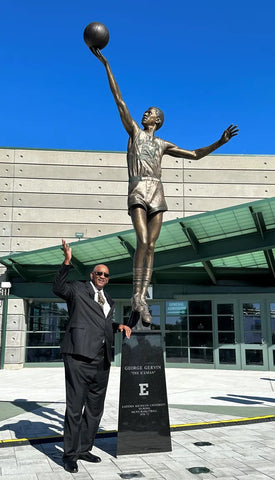
George Gervin with his Statue at Eastern Michigan University
College Career at Eastern Michigan University
He transferred to Eastern Michigan University in Ypsilanti, Michigan. During his freshman season, Gervin showcased his enormous game. He played in only 9 games during the 1970-1971 season for Eastern Michigan, averaging 17.6 points, 11.6 rebounds on 53% shooting.
He stepped his game up significantly as a sophomore, averaging 29.5 points in 1971–1972. He led Eastern Michigan to the 1971-72 final four in the NCAA College Division Tournament. At the end of the season, he was named first-team NCAA-College Division All-America by United Press International in 1971-72.
His time at Eastern Michigan came to a wild end when the cool-tempered Gervin ended up leaving after he got in a fight with an older teammate during an open gym. His potential remained promising to several scouts who managed to get a glimpse of a young Gervin before his time at Eastern was over.
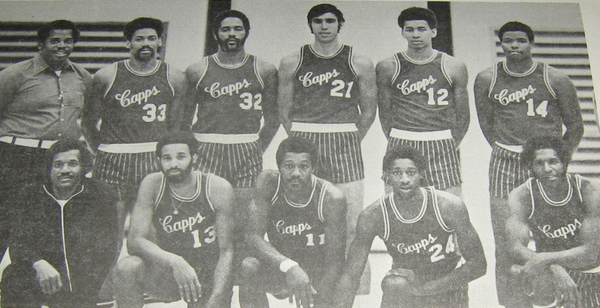
George Gervin at 19 with The Pontiac Chaparrals
The Pros at 19 with CBA's Pontiac Chaparrals
After leaving Eastern Michigan, he signed to play in the defunct Eastern League. There, the 19-year-old continued to display his significant promise, even while competing against grown men. In 1972–1973, Gervin played in Michigan for the Pontiac Chaparrals of the Continental Basketball Association. He earned $500 per month while averaging about 40 points.
While playing with Pontiac, Gervin was spotted by Johnny Kerr the Vice President of Basketball Operations for the Virginia Squires of the ABA. Years earlier, Kerr had received a tip from a friend in college coaching, who told the vice president to look into the young Gervin lighting up scoreboards at Eastern Michigan. Johnny Kerr recalls searching wildly for Gervin but nothing ever turned up on him. One night in his hotel room, Kerr watched a local All-Star game in Michigan, and Gervin magically appeared. Kerr watched in amazement as the 6’8 guard had his way scoring in bunches to the tune of 40+ points.
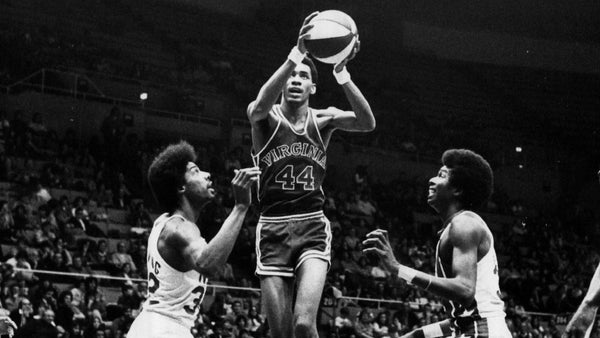
George Gervin for The ABA's Virginia Squires
Signed to ABA’s Virginia Squires & The Iceman Nickname
In January 1973, Kerr signed Gervin to the Squires for a $40,000 a year contract, a serious raise from the $5,000 he made to play in the CBA.
Gervin joined Virginia at midseason and averaged 14.1 points the rest of the way, while his teammate Julius Erving (31.9 ppg) won the scoring title. Squires guard Fatty Taylor took a look at Gervin one day and called him “Iceberg Slim,” a nod to the slender pimp who had just written a best-selling autobiography about his former life on the streets of Chicago. “That’s the image I lived with my whole life,” Gervin said. “Big cars, a big hat. Live fast, die young. People in Detroit, the ones I hung out with, that’s the way they lived.” The name eventually evolved into “The Iceman,” which referred more to Gervin’s on-court composure than to his resemblance to a street hustler. At the end of the season, the Squires traded Julius Erving, which freed up Gervin to be the team's featured player.
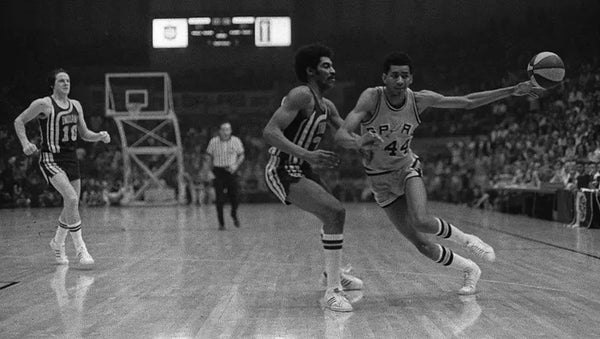
Gervin Goes Against The ABA's Dynasty - The Indiana Pacers
Traded To The San Antonio Spurs
It took 10 games into his second season to see that the Squires had something special in the 21-year-old guard. He was leading a Virginia team in scoring at over 25 points per game. It looked like the young Gervin was sure to be an All-Star selection.
However, the Squires were in bad financial trouble, Johnny Kerr knew they needed to trade Gervin just like they traded Erving. The Squires, however, held the rights to that year's ABA All-Star game. Kerr knew that featuring one star player in the ABA All-Star game was essential to garnering true crowd support, especially after trading league MVP Julius Erving. The Squires agreed to a secret deal in which they would trade Gervin to San Antonio for future delivery, but only after the All-Star break was completed.
The news leaked the same day Gervin played in his first ABA All-Star Game. The Squires immediately tried to back out of the deal as the news got out. The teams and the ABA League Office all had a different interpretation of the deal. The 21-year-old Gervin went into hiding during the week’s time it took to resolve the deal granting his services to the Spurs.
In his first season with the Spurs he scored 23.4 points per game to rank fourth in the league. He remained in the top 10 in scoring and made the All-Star team in each of the next two years. For 48 minutes, Gervin teamed with childhood neighbor Ralph Simpson on the West squad in the 1975 ABA All-Star Game.
His next 2 seasons in the ABA were marked with substantial growth and flashes of future brilliance in his early 20’s.
The Signature Finger Roll
Iceman credited Wilt Chamberlain, Connie Hawkins, and Julius Erving and put his own spin on the finger roll. He became known as the originator, mainly because Gervin’s finger roll had the most style.
George Gervin once said about dunking. “I was a dunker, so I know if you constantly do it, sooner or later, it's going to put that bruise at the bottom part of your wrist. So they need to learn to develop that finger roll.” When he was asked about his signature ‘finger roll’ he said, “I am not the inventor of the finger roll. I kind of just copycatted them.” Over the years, the finger roll has evolved into the famous Jellyroll layup made famous by Isiah Washington, Jahvon Quinery, and others.
Known for his signature move of the finger roll. Gervin had a special talent for spinning the ball just past the outreached arms of an opposing 7 foot defender.
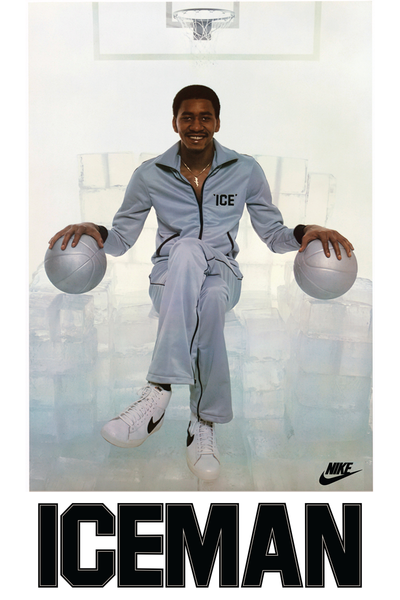
George Gervin's Famous Nike Poster
Signed with Nike
George Gervin was one of the first signature athletes for Nike. He started his career in the popular Adidas Pro Model. In 1972 George Gervin signed with a very young company named Nike. He was famous for wearing the Nike Blazer, complete with his signature nickname 'Iceman' printed on the back of the shoe. “When I first joined the NBA I used to wear adidas and then Nike came on board and Nike approached me and wanted to give me much more money and they had a better quality shoe, I thought. So, I went with Nike through the rest of my career.” For Nike, its partnership with Gervin was all about branding. It was no coincidence that they were new to the industry and designed a sneaker dominated by its logo. Then it found one of the most notorious players in the game, with a nickname for his cool attitude on court and an incredible track record as a shooting guard. The cameras were pointed at Gervin every game, and whenever those cameras caught his feet they found huge Nike swooshes.
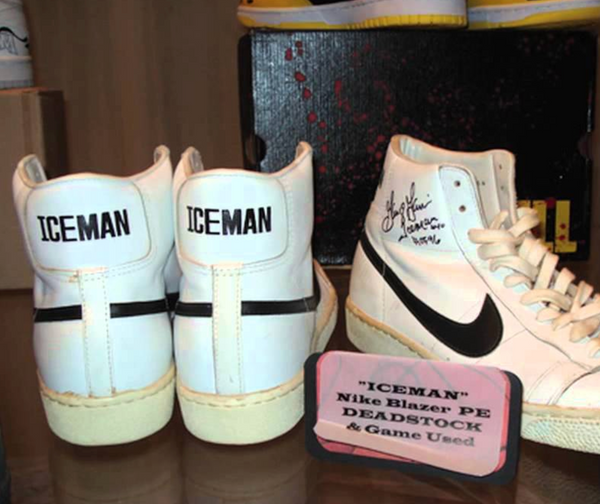
George Gervin's Signature Nike Blazers
At the time Nike’s Blazer was seen as the class of basketball shoes featuring a higher quality leather and performance than the Adidas Pro Model. As his professional career continued, Gervin’s relationship with Nike grew right alongside it, culminating in a uniquely custom Blazer style. What modern sneaker fans would dub a “player exclusive” this Blazer model had “ICEMAN” emblazoned across the heel where “NIKE” usually sat. Player exclusives are one-off color ways or renditions created for players by the brands and are frequently used today to build hype around silhouettes, test color ways, and as a public expression of a brand's commitment to the player. But back in the 1970s PEs were so rare that the Gervin Blazer PEs may very well be the first PE sneaker ever made. The industry was so new at that point that lines between general releases and PEs were not as clear as they are today. What we do know is the ICEMAN PE was never made available to the public and stands as a crucial moment to help define how brands and players interact. Gervin would end his NBA career playing in the iconic Air Force 1.
Nike also produced the famous “Iceman” poster which featured the 6-9 forward in a jumpsuit sitting on a throne made of ice. Nike even produced a special edition of that poster locally for Ice’s Hispanic fans in San Antonio that read: “El Hombre de Hielo” or, translated, “The Man of Ice.”
There was once a team called the Nike Pro club. It originated in 1975. The members included George “Iceman” Gervin, Spencer Haywood, Alvin Adams, Phil Chenier, Charlie Scott, Austin Carr, John Drew, Rudy Tomjanovich and Paul Silas. Rumor has it they rolled around the country on a tour bus challenging existing NBA teams, never loosing a game. In reality The Pro Club rolled like the Sopranos in New Jersey. They took trips to Honolulu, hung out with Phil Knight, played golf, drank champagne, and campaigned. On some of these trips Nike most memorable basketball posters were created. In the trip to Maui, the players were shot at an outdoor court, dressed in athletic gear, wearing Nikes and holding instruments. The theme was Jam Session. Another was in Reno, Nev., and the theme was the Supreme Court with the players dressed in robes and wearing Nikes. The final group shot took place in the summer of 1982 at the Meadowlands in New Jersey. The picture, which is the most iconic shot of the three, has all 28 players dressed in suits and is called the Board Room. Broom hockey in Sun Valley was a popular activity for the Pro Club. “You had the best basketball players in the world skating around on the ice with brooms,” Alvin Adams says. “Phil Knight even played with us. Of course he wasn’t Phil Knight then. He was just the head of a little shoe company, and he would check you into the boards if you were between him and the puck.” Special rings were made for members only. They were a professional basketball syndicate. The Pro Club tested different shoes for this brash company called Nike. They’d try out different designs and models of different shoes and report back. Some of the earliest product testing there was. The company called them a focus group. The payoff to join the Pro Club got sweeter through the years. The players received royalty checks each year based off the annual sales of basketball shoes. The cut started around $12,000. In 1982, the paid raised and each player got a royalty check of about $50,000. Years later a Nike designer paid homage to the group by designing the Nike Delta Force 3/4, a thank you to the original Nike dream team.
.

Detroit St. Cecilia's Gym
Detroit's St. Cecilia
When Derrick Coleman was in high school, word of mouth on the streets of Detroit would spread news that George Gervin was coming to town to play at the tiny gym on Livernois Avenue and Stearns Street known as 'The Saint,’ or St. Cecilia.
In the summer of 1974, the gym’s reputation swelled, thanks to the patronage of future Hall of Famer, and Detroit mayor, Dave Bing. The Pistons had selected Bing, a Washington, D.C., native, with the second pick of the 1966 draft. Eight years later, the point guard had a contract dispute with the organization and was barred from using team facilities. “Sam was a fixture of Detroit basketball even then, and he invited me to work out at St. Cecilia,” Bing said. Word spread quickly, especially after Washington Sr. asked if Bing would like to play in a tournament at the Saint. “I brought Jimmy Walker [Jalen Rose’s father], Ralph Simpson, and George Gervin,” Bing said. “After that, St. Cecilia became the place in the Midwest where you had to play.”
"George “The Iceman” Gervin would put on a show every time they walked in the gym. It was wall to wall with people packed in the gym, with 200–300 outside waiting to get in. If you got up you would lose your seat immediately. I never got up.” Recalled Derrick Coleman

George Gervin with fellow Detroit Native Magic Johnson
ABA To The NBA
During the 1976-1977 season, Gervin transitioned from the ABA to the NBA in the merger. His team, the San Antonio Spurs, was one of the four teams brought over to the NBA from the ABA. Writers and skeptics questioned whether the teams and stars of the ABA would have any success in the NBA. In his first season, Gervin and his ABA cohorts answered that question definitively. Iceman himself averaged 23 points, and led the Spurs to the playoffs with a 44-38 record. Iceman was selected as an NBA All-Star during his first year in the league.
Do Or Die from Victory Journal on Vimeo.
Iceman vs Skywalker - Spirit of 1978
In the closest scoring race in the NBA history, George Gervin won his first scoring crown. In the 1977–78 season, he narrowly edged David Thompson for the scoring title by seven-hundredths of a point (27.22 to 27.15). The scoring title came down to the last day of the season, when both guards put on legendary scoring performances.
David Thompson came up with a memorable performance for the last game of the regular season, scoring 73 points. Gervin maintained his slight lead by scoring 63 points (including a then NBA record 33 points in the second quarter) in a loss. With the scoring crown in hand, he sat out some of the third, and all of the fourth quarter. We will let George Gervin retell the rest from memory.
“Do you want to go for it today?” “Coach Brown asked me before the game. Whether we won or lost, we were still headed for the playoffs. So the coach was willing to let me shoot to my heart’s content to win the NBA scoring title. If I put up astronomical numbers, then Gervin, playing in New Orleans that evening, would be chasing me.”
“There were no camera crews at Cobo that afternoon for two primary reasons. First, our game was truly meaningless as far as both teams were concerned. Second, the network saw bigger ratings in John Havlicek’s farewell game at Boston Garden, the Celtics versus the Buffalo Braves. No argument there. The individual scoring title really wasn’t that big a deal, to me or the media.” “I hit the first eight shots I took, mainly medium-range jumpers from 15 to 18 feet. As the quarter wore on, I also got a few dunks on alley-oops. The 6-foot-9 Poquette stuffed me cleanly on one dunk attempt, but I connected on my last five shots of the first quarter, and we took a six-point lead into the second stanza, 42-36.” recalled Gervin.
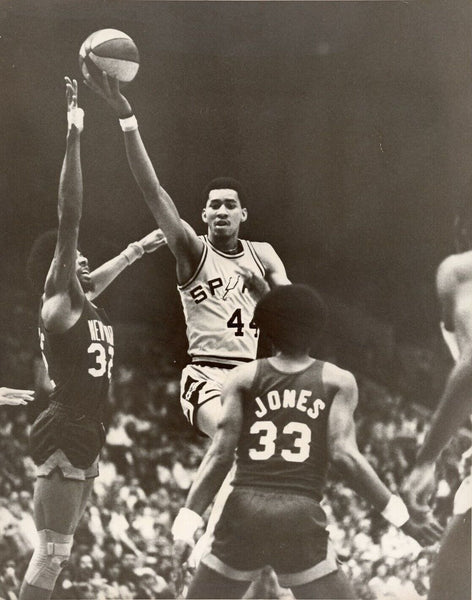
Scoring Machine
Prior to Michael Jordan, Gervin had the most scoring titles of any guard in league history. He led the league in scoring during the 1979-1980 season, averaging a career high 33.1 point per game while shooting nearly 53% from the field. In 1981-1982 he averaged 32.3 points per game, leading the league in scoring for the last time in his career. Ice, ranked in the league’s top 10 in scoring for eight straight seasons, and shot 51.1% from the field throughout his NBA career,, almost unheard of for a perimeter player.
“I shot 51% in my career, getting 26,000-something points (26,595). Most of them guys that’s up there in that same category, they shot 30 times to get 30 points. I prepared myself to be able to try to handle whatever defense was thrown at me. I think that made a difference for me in my career. I worked at my craft. I just loved the game. So, that gives you confidence and builds up your self-esteem. Then mentally, it makes you ready for whatever comes at you.”
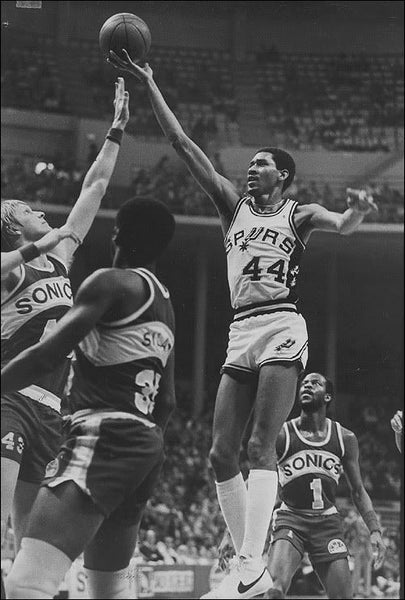
George Gervin Finishes with His Signature Finger Roll Over Jack Sickma
San Antonio Couldn’t Win The Big One
San Antonio featured several great players throughout the 70s and 80s. Among his best teammates were Center Artis Gilmore, Point Guard James Silas, Forward Mike Mitchell, and Center Billy Paultz. They were a perennial contender in the West, even when they made the leap from the ABA to the NBA.
In the 1978–79 NBA season, the Spurs finished 48–34, good enough for second seed in the Eastern Conference, they had made it past Julius Erving and the Philadelphia 76ers in the second round, beating them in seven games as Gervin led the league in playoff scoring with 28.6 points per game.They were one win away from making it to the 1979 NBA Finals as they were up 3–1 against the Washington Bullets in the Conference Finals but collapsed by losing three straight to lose the series.
1979-1980 was Gervin’s best scoring season at 33 points per game. But during the 1980 playoffs they lost in the first round 2-1 to the Houston Rockets, Gervin averaged 33 points per game on 50% shooting in the series. But it was Moses Malone that dominated averaging 27 points per game and 17 rebounds per game. The Spurs had no answer for Moses.
In 1980-1981, while sitting out three games due to injury, Gervin's replacement, Ron Brewer, averaged over 30 ppg. When Gervin returned, he scored 40+ points. When asked if he was sending a message, Gervin said, "Just the way the Lord planned it" and added, "Ice be cool" (with Ron Brewer). They finished the season with a 52-30 record under coach Stan Albeck, which earned them the 2nd seed in the Western Conference. The playoffs had a similar ending to the previous year, as the Spurs lost to the Houston Rockets in 7 games. Once again George had his way averaging 27 points on 50% shooting, but it was not enough as Moses Malone dominated with 28 points and 12 rebounds per game in the series.
In the 1981–82 season, the Spurs would once again compete for a championship. At this point, the Spurs had just become a Western Conference franchise. Once again finishing second in the conference with a 48–34 record. Gervin carried the team in scoring by leading the league with 29.4 ppg. They defeated the Seattle Supersonics 4 games to 1 in the first round. Gervin and teammate Mike Mitchell owned the series, averaging more than 50 points between them. They had made it to the Conference Finals but got swept by the number one seeded Los Angeles Lakers who would end up winning the championship that year.
The Spurs added a significant piece in a Center Artis Gilmore during the 1982-1983 season. The 7’4 Gilmore might have made the difference during the 1980 and 1981 season, which saw Moses Malone wreck the Spurs playoff hopes in two straight seasons. In 1982-83, they finished the regular season 53-29 overall, good enough for the 2nd seed in the playoffs for the third straight year. In the first round Gervin dominated the Denver Nuggets averaging 28 points on 60% shooting. The Spurs won the series 4-1. In the second round they faced the Showtime Lakers featuring Magic Johnson and Kareem Abdul-Jabbar. Michael Cooper’s defense helped to contain Ice to just 22 points per game on 45% from the field. The Lakers would go on to win the series in 6 games.
83-84 - This year marketed the toughest year for the Spurs in Iceman’s career. Despite having Gervin and Gilmore the team missed the playoffs going only 37-45 in the regular season.
84-85 was his last year in San Antonio, he averaged just 21 points per game, his lowest since his first season in San Antonio, more than a decade earlier. They narrowly made the playoffs with a 41-41 record, where they lost in the first round to a high-scoring Denver Nuggets team. Game 5 in Denver was Gervin’s last game in a Spurs uniform.
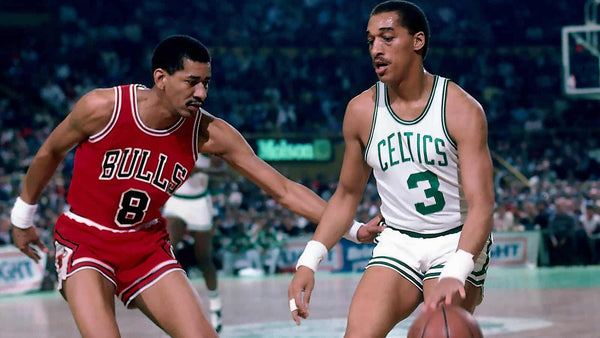
George Gervin with The Chicago Bulls in 1986
Time with Michael Jordan and the Chicago Bulls 1985-1986
He played a single season with second-year standout Michael Jordan and the Chicago Bulls. Jordan was not happy with the trade as it was sending Dave Greenwood to San Antonio. Critics pointed to the fact that Gervin was past his prime. Gervin played in all 82 games while Jordan would sustain a broken foot and play in just 18 games. In his last season in the NBA, Gervin averaged 16 points per game on 47 percent shooting. His playoff role was reduced to 5 minutes per game as the Boston Celtics swept the Bulls in the first round of the 1986 playoffs. Gervin said one of his reasons for retiring was watching a young Jordan score 63 in the Boston Garden.
Banco Di roma, TDK Manresa and Quad City Thunder (1986-1990)
One of the first prominent NBA stars to play overseas. Gervin played in Russia for Banco di Roma during the 1986–1987 season. He averaged 26.1 points per game.
The following year, Gervin played in Italy for Banco Roma and scored 26.1 points per game. As a newly retired player, Gervin had trouble making the transition. He developed a substance abuse habit that required three trips to rehabilitation clinics to break. The last visit came in 1989 at a Houston facility run by former Spurs teammate John Lucas.
In the 1989-90 season, he attempted a brief comeback with the Quad City Thunder of the CBA, appearing in 14 games and averaging 20.3 points.
Gervin played in the Spanish National Basketball League for TDK Manresa team (he was 38 years old at the time). At this point in his career, he averaged 25.5 points, 5 rebounds, and 1.2 assists. In his last game of the season he scored 31 points and grabbed 15 rebounds to keep Manresa in the first Spanish division.
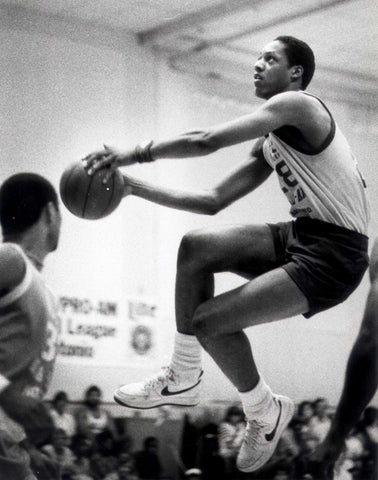
Brother Derrick Gervin
A little-known fact about George Gervin is that he had a brother named Derrick Gervin. The little brother was a 6-8 power forward who played college ball at the University of Texas San Antonio. He also played at Martin Luther King in Detroit just like his older brother. Although he was drafted in the 4th round, Derrick played two seasons in the NBA for the New Jersey Nets. The younger Gervin put up respectable numbers, averaging 12 points and 3 rebounds in his first NBA season.
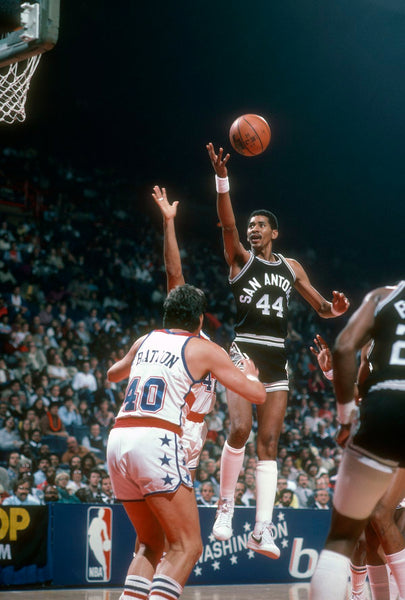
George Gervin Scoring Against The Washington Bullets
The Legacy of Iceman
GGervin was inducted to the Naismith Memorial Basketball Hall of Fame in 1996. He was named as one of the 50 Greatest Players in NBA History in 1996. In 2021, he was also named as one of the 75 greatest player in NBA history. His #44 jersey is one of only 2 jerseys retired by the San Antonio Spurs franchise.
Iceman famously led the NBA in scoring 4 times. He played in 12 All-Star games. He was selected to the All NBA 1st team 5 times, All-NBA 2nd team 2 times and All ABA 2nd team 2 times. He was named as one of the 75 greatest players in NBA history. In the 1978 and 1979 season Gervin came 2nd in MVP voting. In the 1980 NBA All-Star game he took home the MVP trophy after scoring 34 points and pulling down 10 rebounds. As the East won the game 144 to 136. One of the three players in NBA history to average 30 PPG and shoot 50 percent on field goals in a season as a guard, the others include (Michael Jordan, Stephen Curry, and Shai Gilgeous-Alexander). He remains one of the best players who never made an appearance with a team in the NBA Finals.
He helped to start The George Gervin Youth Center (GGYC) a pre-K through high school academy to retirement housing for those age 62 and older. Gervin continues to help the community of San Antonio to the current day.
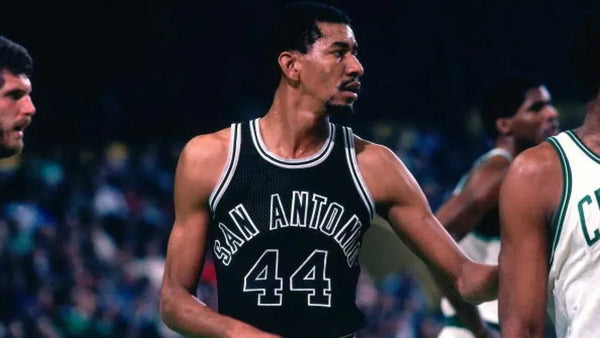
There was his time in the ABA, which has gained cult status since its demise in 1976. There was the legendary finger roll move that continues to be celebrated today. His Nike Blazer continues to be a celebrated shoe still worn today. The iconic Iceman poster has also reached a cult status, gaining upwards of $500 on ebay. The tall 6’8 guard was one of the first of his kind inspiring future scoring machines like Kevin Durant. Shop our tribute to Iceman here. Cooler than the other side of the pillow indeed.

